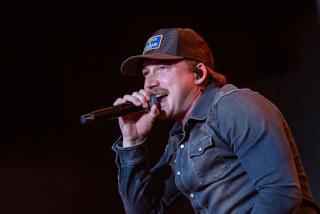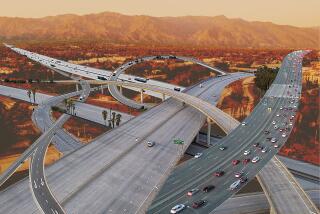AMERICA’S CUP ’92 : Conner’s Boat Goes Truckin’ Coast to Coast : Stars & Stripes: After overland trip from Rhode Island, it’s scheduled to be christened Sunday.
SAN DIEGO — What’s midnight blue and white, 75 feet long, 15 feet 6 inches wide and 13 feet 6 inches high? And how--why?--does anyone move it from Bristol, R.I., to San Diego?
“It’s a sailboat,” Mick Harvey explained to curious onlookers along the way.
One Texas skeptic, judging that Harvey was looking for a launching ramp, considered this information as he drilled a lizard with his chewing tobacco and responded: “Well, it ain’t gonna fit in any lake around here.”
Just passing through, pardner. This isn’t just any boat. And it isn’t just another of the two dozen or so new International America’s Cup Class that will arrive over the next few months by land, sea and air.
Some other boats will arrive in time for the first IACC World Championships May 4-11 and others for the challenge and defense trials starting in January. But none will rate the fanfare this one will receive, starting Sunday with what PR firms call a “gala christening.”
It’s Dennis (America’s Cup) Conner’s boat, for gosh sake, the newest generation of Stars & Stripes in all its promised glory.
The eight previously in port--one from France, two each from Italy and Japan and three from New Zealand--were brought by freighters. Italy, the Soviet Union and perhaps France plan to bring others by air.
None will sail across oceans under its own power. Nobody has done that since 1937 when T.O.M. Sopwith brought Endeavour II from Britain to lose to Harold Vanderbilt’s Ranger, 4-0, at the end of the J-Boat era.
Team Dennis Conner elected to ship overland, escorted by Harvey, an Australian. It arrived last week after what might be regarded as an informal sort of pre-victory tour, but in fact the only options were to fly it for $250,000 or ship it through the Panama Canal, which would have taken a lot longer. Trucking was cheaper than flying and faster than shipping.
As it is, Harvey and operations manager Bill Trenkle and their crews will be scrambling to put the boat together for its coming-out party Sunday. The 110-foot mast and 30,000-pound keel, both fabricated in California, were arriving separately.
Harvey is Conner’s construction supervisor who midwifed the birth of the newest member of the Stars & Stripes family at Eric Goetz’s boatyard in Rhode Island. Bruce Nelson, David Pedrick and Alberto Calderon designed it, with Chris Todter coordinating their efforts. Goetz (pronounced gertz ) built it of carbon-fiber material.
Conner will sail it.
Conner won the Cup back from Australia with Stars & Stripes ‘87, a 12-meter that is already a museum piece. In 1988, he defended it against New Zealand’s aircraft carrier-like monohull with the Stars & Stripes catamaran, which tourists now joy-ride at Acapulco.
Conner skippered his first Cup victory in 1980 with Freedom, a blue boat like S&S; ’87 and the catamaran. Liberty, in which Conner lost the Cup to Australia in 1983, was red.
There wasn’t much discussion about what color this boat wouldn’t be. A red boat has never won the America’s Cup--take note, Il Moro and Mercury Bay.
Harvey accompanied the new Stars & Stripes on its 3,500-mile cross-country odyssey. He is an interesting study himself.
Ask him where he lives and he’ll explain that he’s from Port Lincoln, a small town in south-central Australia near Adelaide, However, he will further explain that he has lived around the U.S. for 10 years while serving as captain for several maxi boat programs and acquiring an American wife, Cathy. The logistics of a maxi program are similar to an America’s Cup, so Conner hired Harvey to handle Stars & Stripes.
“My residence is in California,” he says, vaguely. “But I’ve been living in Rhode Island the last few months. It depends on how you define living. I really don’t have any permanent address. You just follow it around.”
Mick and Cathy followed the boat out of Goetz’s yard at 8 a.m. EST on Tuesday, March 19. It was laid facing backward on its side, like a beached whale, on a transport trailer with flashing lights on escort vehicles front and rear.
California, here we come. Harvey hoped it would take six days. It took seven. They visited 14 states, with overnight stops in Harrisburg, Pa., and a couple of towns tourists miss if they blink--Atkins, Va.; and Lebanon, Tenn.--then Texarkana, Tex.; El Paso, Tex.; and Yuma, Ariz.
“The problem is that for oversize loads, every state has a different law,” Harvey said. “You can’t just go and say, ‘I want a permit to go from Bristol to San Diego.’ You have to deal with each state authority.
“The trucking company took care of all that (in advance), but it still depends on who’s doing the permit and what kind of day they’ve had as to where they’re gonna route you.
“We could only travel from sunup to sunset in every state. There were times when we were still 20 miles from the truck stop when the sun was going down. But legally we were fine because we still had another half-hour of daylight.
“Arkansas, we didn’t go on an interstate at all. We went on secondary roads. We traveled an extra 100 miles farther than what we had to. Frankly, I think it’s dangerous. You take up the whole road, traveling along at the speed limit--55 or 65 m.p.h., depending on the state--because you’ve gotta get there.”
Nevertheless, the best day was winding through Arkansas: 660 miles. The worst was the day before, when they had to stop at 3 in the afternoon at Lebanon, Tenn., after only 300 miles.
“A lot of states have curfews for wide loads,” Harvey said. “You can’t travel through the big towns at rush hour from 3 to 7 in the afternoon. You’d clog the traffic up too much.”
Out of Bristol, they picked up I-195 in Massachusetts, then headed southwest into Connecticut and New York state on I-95 and into Pennsylvania. Dipping into Maryland, they wheeled through West Virginia, stopping for the night at Atkins, Va.--pop. 500 and the gateway to Hungry Mother State Park. On to Knoxville, then I-40 through Nashville and a series of side roads from Memphis through Arkansas.
“We didn’t have any close calls except on the secondary roads in Arkansas, when we were running people off the road,” Harvey said. “They just had to get out of our way.
“We’d be going across the swamps on a causeway. Most roads have shoulders. There was this one stretch across the swamps in Arkansas that was like a causeway, and it didn’t have any shoulders. So we were just trucking along, taking up two lanes. When people were coming the other way we had to get over as far as we could to the right, and they were like right on the edge, too.”
Leaving Arkansas, they picked up I-30 at Texarkana to Ft. Worth, then took I-20 to I-10 in the wilds of southwest Texas and switched to I-8 at Casa Grande, Ariz., for the last leg to San Diego.
“We didn’t have too many glitches at all,” Harvey said. “Massachusetts (on I-195) was the only place we had to have (an escort of) state troopers. Had ‘em for like 15 minutes.
“Around Danbury, Conn., we lost a pin out of one of the axles on the trailer and the wheel skewed back. But because the boats are light, the trailer had more axles than it needed for the weight, so we just took the wheels off and chained it up out of the way and went on three axles until we got just outside of Harrisburg, Pa., where we stopped that night. World Marine had a team come in and repair it.
“In Texas, we had trouble with the shrink-wrap covering on the boat. It started to come off in the heat and the wind. We had to take three hours to cover the boat in netting. It helped camouflage it a little more.”
There also were four flat tires.
“We had pretty good weather until (the last night) in Tennessee when we had some thunderstorms and tornadoes,” Harvey said. “We didn’t see any, but the forecast said they were all around us.
“And the next day we were traveling through rain squalls and thunderstorms all through Arkansas. We heard on the radio there were tornado warnings in effect most of the way across the state.
“When we got into Texas, it was beautiful sunshine--until we got to California.”
Fifteen miles east of San Diego, the intrepid group ran into a snowstorm in the Cleveland National Forest, delaying the arrival by about 2 1/2 hours. They pulled into the compound behind the San Diego Convention Center at 1:30 p.m. Tuesday afternoon.
Harvey thinks Stars & Stripes made new friends, coast to coast. Conner’s fame seems to be nationwide.
“Some people you’d never think would know, like out in the middle of the Midwest, would say, ‘Oh, yeah, I’ve heard about him. He’s gonna go race for the American (sic) Cup.’
“It’s surprising the number of people that do know about the America’s Cup. We all had CB radios. A lot of the truck drivers had it figured out what it was. Over the years, a lot of 12-meters have been trucked across the country.”
The boat collected graffiti. Someone in Dallas wrote: “Good luck, Dennis. Soling Fleet 28, Rush Creek Yacht Club.”
Another: “Koch vs. Pepsi (a Conner sponsor).”
Even Smokey was friendly.
“We didn’t get any tickets,” Harvey said. “The truckers said that was pretty amazing--not because we were breaking the law, but the state troopers tend to see a big load like that and nit-pick.
“They were all great. A lot of the police came up alongside and chatted to the drivers on the CB and wished us luck.”
THE CHRISTENING
What: Christening of International America’s Cup Class boat Stars & Stripes.
When: Noon Sunday (spectators advised to arrive early).
Where: San Diego Embarcadero, near The Berkeley.
How much: Free.
What else: Fireworks, Navy tribute, boat parade.
More to Read
Go beyond the scoreboard
Get the latest on L.A.'s teams in the daily Sports Report newsletter.
You may occasionally receive promotional content from the Los Angeles Times.










